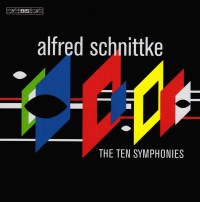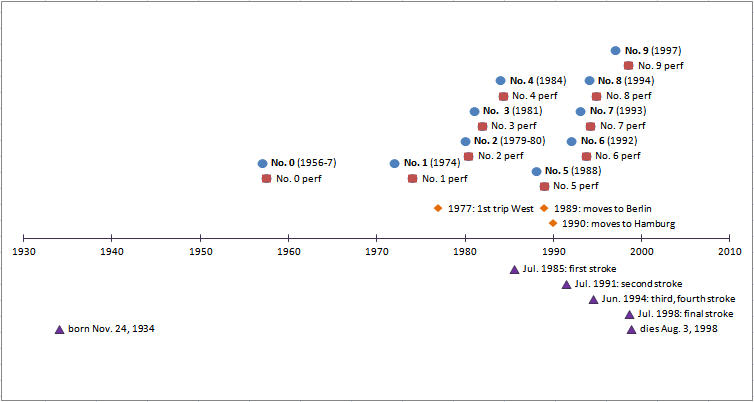Mostly Symphonies 24: Schnittke’s Ten
|
Grant Chu Covell [September 2013.]
“The Ten Symphonies.” Alfred SCHNITTKE: Symphony No. 0 (1956-57)0; Symphony No. 1 (1972)1; Symphony No. 2, “St. Florian” (1979-80)2; Symphony No. 3 (1981)3; Symphony No. 4 (1984)4; Concerto Grosso No. 4 – Symphony No. 5 (1988)5; Symphony No. 6 (1992)6; Symphony No. 7 (1993)7; Symphony No. 8 (1994)8; Symphony No. 9 (1997; compl. Alexander RASKATOV, 2006)9. Carl-Axel Dominique1 (pno), Ben Kallenberg1 (vln), Åke Lännerholm1 (trb), Mikael Bellini2,4 (c-ten), Göran Eliasson2 (ten), Malena Ernman2 (alt), Torkel Borelius2 (bass), Stefan Parkman4 (ten), Lucia Negro4 (pno), Christer Thorvaldsson5 (vln), Helén Jahren5 (ob), Per Lundberg5 (hpsi), Nicola Boruvka5 (vln), Magnus Lundén5 (vla), Anders Robertson5 (vlc), Maria Nyberg5 (pno), David Nolan7 (vln), Mikaeli Chamber Choir2, Academy Chamber Choir of Uppsala4, Royal Stockholm Philharmonic Orchestra1,2,3, Stockholm Sinfonietta4, Gothenberg Symphony Orchestra5, BBC National Orchestra of Wales6,7, Norrköping Symphony Orchestra8, Cape Philharmonic Orchestra0,9, Leif Segerstam1,2, Eri Klas3, Okko Kamu4, Neeme Järvi5, Tadaaki Otaka6,7, Lü Jia8, Owain Arwel Hughes0,9 (cond.). BIS CD 1767/68 (6 CDs) (http://www.bis.se/). BIS rebundles a most idiosyncratic and essential symphonic cycle. Except for distantly spaced encounters, I had never considered Schnittke’s symphonic arc from start to finish. I did enjoy Nos. 8 and 9 without hearing their predecessors. My loss. In offering six CDs for the price of two, BIS makes it easy for everyone to explore Schnittke’s astonishing series. The composer makes explicit from his First (1972) that he has inherited a worn-out collection of tools. With Mahler and Shostakovich as unshakable ancestors, Schnittke stakes out the endpoint of a tradition which started with Haydn and Beethoven. He does little to rejuvenate the genre. Forms and dimensions defy convention (e.g., the Seventh’s unusually proportioned movements); effects aren’t shaped by causes (e.g., themes in the Second and Fifth occur at their variations’ conclusions). The symphonies are an excuse to gather and willfully misemploy an army. Schnittke (1934-98) was a consummate orchestrator with encyclopedic mastery of classical and popular gestures. In the ballet and film scores this breadth reveals itself through humorous juxtapositions: A harpsichord mingles with electric guitar, a Mozartian melody appears on xylophone, or an 18th-century brass fanfare abruptly intrudes. The symphonies also array unexpected combinations and contradictions. Alexander Ivashkin’s notes for BIS suggest that Schnittke constructed his symphonies as narratives, patterns sparked by the ideas of the philosopher Mikhail Bakhtin. Schnittke’s symphonies are processions and carnivals which parade varied and often opposing ideas. Most symphonists strive for closure, transformation or complete statements. Schnittke’s symphonies can be unsettling because conflicts are presented without resolution. Similar to the maturation of Mahler’s cycle, Adagios and Lentos become the emotional centers. Would we listen to No. 0 if Schnittke hadn’t written all that followed? Probably not; it’s conventional and lengthy without being essential. This polished student effort employs Shostakovich and Miaskovsky as models. The composer’s obligatory mid-century dalliance with serialism occurred after No. 0 and before he started working on his first mature symphony. The monstrous First (72:27) is a circus elephant cavorting in a village square. It proudly flaunts its “polystylistic” label with a multitude of quotes, styles and overlapping interruptions. If the Soviet system permitted its performance in 1974 in semi-remote Gorky (now Nizhny Novgorod) instead of Moscow, it may have been because its anarchy appeared to take no sides. There are jazz interludes, specified stage entrances and exits, intruding applause, and many musical quotations. Because the work is so long and arduous, there’s little humor when the Dies Irae, Beethoven’s Fifth or Tchaikovsky’s First Piano Concerto appear. The Baroque circus and the violin-plus-piano jazz combo in the second movement can be bewildering. Schnittke had been working on the First along with a film score for Mikhail Romm’s And still I believe. The filmmaker’s collection of varied documentary footage enabled the composer to try something similar in a symphony. The intent aligns with Ives’ work the simultaneous ideas of which often reflect the universe’s variety (they could also symbolize people disagreeing). The effect is not intended to charm or suggest similarities between past and present as in B. A. Zimmermann’s Requiem or Musique pour les Soupers du roi Ubu. Considering Ivashkin’s Bakhtin observation, experiencing the First is like paging through a publication with articles that jump across facing pages – a model perhaps helpful in understanding Schnittke’s symphonic forms. Except for the Fourth and Eighth, the symphonies do not culminate in catharsis. The journey is the point. The Second, ostensibly a Mass commemorating Bruckner, rummages through religious gestures and chants. A chorus opens the Kyrie, and harpsichord and clanging percussion soon intrude. No. 1 is considered the most polystylistic. No. 2, the sacred twin of the secular First, comes close. No. 3 returns to the First’s formal preoccupations, with Schnittke challenging the Germanic symphonic form from within. It is possible to look at Schnittke’s cycle and see the odd-numbered symphonies as the more extrovert, in contrast with the private, even sacred even-numbered symphonies. And yet the demarcation easily blurs. Schnittke derives monogrammatic motives from his symphonic ancestors’ names, but then conceals them. The Fourth, a second choral symphony, reflects Schnittke’s religious quest. Straddling Germany and Russia, and a Jewish and atheist heritage, he found himself drawn to Christianity. The continuous 40-minute span contains 22 variations whose themes only become apparent at the choral conclusion. With a prominent piano part and two vocal soloists, Christianity, Judaism and Russian Orthodoxy swirl together. Is it confused or resolute? Among the Fourth’s contradictions are the 22 variations based upon the 15 decade Rosary. Like the preceding odd-numbered symphonies, the Fifth takes on musical forms and history. The Concerto Grosso No. 4 / Symphony No. 5 explicitly morphs two favorite Schnittke genres (the next odd-numbered symphony does something similar): The opening concertante Allegro (with solo oboe, violin and harpsichord) becomes subsumed into a dramatic symphony. In the second movement, Schnittke provides a despondent elaboration upon Mahler’s early and incompleted Piano Quartet. In a typical Schnittke ploy, Mahler’s original appears at the end of the movement rather than at its head, as if Mahler has completed Schnittke. The concluding two movements possess vehemence akin to Henze’s Seventh (1983-84). Things change with the Sixth, completed after the composer’s second stroke. Dissonance is permanent, the material sparer and the forms and relative movement sizes less conforming. Similarities with the First’s overt pastiche are still evident: The collaged materials are clusters, meandering snippets, non-thematic gestures. The Sixth’s four movements (TT=33:21) contain few tuttis. Material moves across instrument groups without background. It is as if a denser work was erased leaving deficient fragments. Schnittke frequently uses a wedge shape, where a single note fans out into a cluster. There are also melodic lines which creep chromatically like the B-A-C-H motive. The Seventh offers three unequally sized movements: A 5:02 Andante introduces a solo violin as if a concerto, followed by a perplexingly short Largo (2:33), and a final long Allegro (14:29) which evaporates into a sad tune played by contrabassoon and bass. Built from composer monograms, the tiny Largo catalogs despondent linking gestures. The dreary quintessentially Russian closing tune, a rare passage of melody over accompaniment, leads to an unresolved end. The five-movement Eighth’s simplicity and brutality are exceptional. I had admired No. 8 before, and experiencing it in sequence makes clear what a bleak and gripping culmination this is, launching as it does with a chromatic jumping melody over the barest accompaniment with its Mahler scowl. In the second and fourth movements, Schnittke uses a major-triad arpeggio to instill terror. The central Lento brings on the strings in a thin but dissonant Mahler-like Adagio. The final movement is a luminescent ascension, an extension of closing gestures heard at the end of Nos. 1 and 5. The climbing scale with held pitches creates a shimmering cluster. The reconstructed No. 9 does not provide Schnittke’s series with a tidy capstone. Deciphered from the composer’s post-stroke handwriting, it isn’t as bruising as the austere No. 8. Indeed, what we have suggests a new direction. The tempo in each of the three movements increases, from Andante to Moderato to Presto. I suspect that Schnittke might have wanted to work on it more. One is reminded of Xenakis’ last compositions, also written during a final illness: Note values are fairly consistent across movements. The completion by Alexander Raskatov results in a thicker orchestration than that suggested by the Sixth, Seventh and Eighth. Those with affection for Mahler and Shostakovich’s symphonies should engage with Schnittke’s cycle. While the polystylistic works may be disconcerting, after the Sixth, Schnittke’s stature is clear. At present BIS offers the only complete series, which makes this bargain-priced set essential. Chandos seems destined to catch up someday (they have 1, 2, 4, 6, 7 and two 8s). ECM has No. 9. A Rozhdestvensky bundle would appeal. He premiered four. Some are on hard-to-find Melodiya LPs and CDs. BIS groups the symphonies: 1; 2; 3 and 7; 4 and 5; 6 and 8; 0 and 9. The First and the Sixth are not the strongest recordings. Do we really need 4:21 of applause after the First’s concluding chord? With its migrating players, the First is especially difficult to capture on recording, a fate shared with Chandos 9714. It’s overdue for an SACD or DVD presentation.
[More Grant Chu Covell, Mostly Symphonies]
[More
Schnittke]
[Previous Article:
Seven more last words]
[Next Article:
Airscoop Dest’ny]
|

